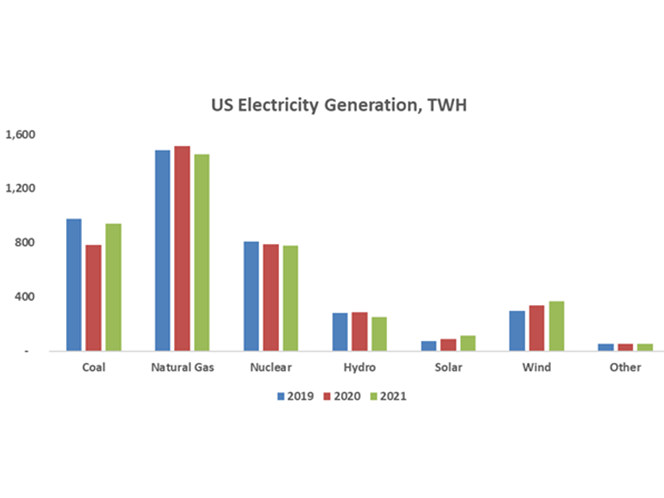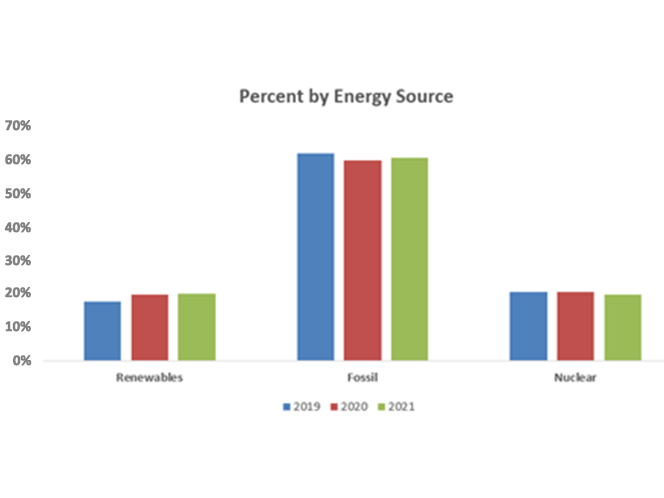Five challenges renewables must overcome to surpass fossil fuels
Posted: Feburary 16, 2022
Renewable energy is the fastest-growing energy source in the United States, but that growth presents new challenges. While fossil fuels still make up 60% of total US generation, solar and wind now account for the majority of new generation capacity. Electricity from nuclear and renewable sources each make up 20% of U.S. generation. While technological advances have led to efficiency and costs gains to enable electricity generation from renewable sources, the renewable energy field must overcome considerable challenges before it can replace fossil fuels.


Intermittency
Currently, fossil fuels are more reliable when compared to renewable energy resources. For example, solar energy is far more intermittent because half of the world is dark at any given time. Solar cell efficiency is also highly dependent upon the sun’s height above the horizon. Clouds and other obstructions can also further decrease the dispatchability of solar power. Wind doesn’t blow all the time, creating similar intermittency issues. Both can be unpredictable depending on location and weather.
The intermittent nature of most forms of renewable energy requires energy storage, usually in the form of batteries. The cost of storage, as well as the cost and complexity of managing charging and discharging cycles, can negatively affect the return on renewable generation investment.
Fortunately, advances in battery technology, software, and electric grid integration methods are making energy storage more reliable and affordable. As technology adoption increases and future advancements are made, the industry is poised to overcome current storage challenges. However, battery production requires rare earth metals. To avoid future pitfalls, manufacturers must increase efforts to reclaim these metals to create sustainable battery production.
Electric grid stability
Renewable energy is typically generated away from large populations, such as in large deserts or offshore. Transporting energy from where it is generated to where it is consumed puts greater pressure on existing grid infrastructure or requires new transmission lines. Adding new poles, wires, transformers, and more requires considerable investment to move renewable electricity from remote areas to the homes and businesses that consume it.
Most electrical power grids are not suitable to handle the rapid growth of renewable energy. Developing countries need to modernize or replace ageing infrastructure and rapidly expand power networks to meet growing demand. Developed economies built their infrastructure in the 1950s and 1960s, and that aging infrastructure must be upgraded. Besides exceeding the 50-year life expectancy, these lines were not designed for the today’s electricity demands or the added pressures from new, smart grid technologies or regulations.
Besides the ageing infrastructure and limited capacity of the existing grid, the increase in renewal penetration makes grid stability a paramount concern. The existing grid was designed to move electricity from large, centralized plants to the demand centers. Besides being one-directional, the electric grid has large mechanical inertia stored in the metal of the turbines generating electricity. This inertia makes the grid inherently stable, lending itself to efficient frequency control in cases of upsets of disruptions. As generation from fossil fuels is displaced the grid mechanical inertia decreases, requiring new methods of frequency controls to ensure grid stability.
In addition, as renewable generation increases, the electric grid must be able to handle bi-directional flows of electricity, depending on time of day and the type of generation available. A solar plus energy storage asset can be a producer of electricity during the day and an electricity consumer to charge the battery from the grid during later hours.
Economic factors
Economics may be one of the biggest challenges the renewable energy sector currently faces. Bringing these energy sources to the masses requires major investments that won’t return profits in the short term. These costs can be measured in terms of the levelized cost of energy (LCOE), which is the net cost per unit of electricity over the course of a plant’s lifetime. The utility industry traditionally bases its estimate of a project’s LCOE on historical data, but this data is scarce for renewable energy.
Government incentives in the U.S. have helped lower the cost of developing renewable energy plants over the past decade, making them more cost competitive with fossil fuels. However, the current incentives are scheduled to expire over the next few years, creating uncertainty about the ROI of renewal energy projects.
Land use
Land use often becomes a point of contention in renewable energy projects. Balancing the land requirements for renewable energy against the many other important uses for this natural resource remains a major challenge. The decision to build a solar energy or wind turbine farm often comes down to whether that land would be better used for housing or food production.
The most likely solution to this problem will involve using land for multiple purposes, such as growing crops or raising livestock, while also producing energy from solar and wind sources. The challenge will be to install wind or solar farms without disrupting livestock grazing or crop production. Scientists are currently conducting research on the feasibility of interplanting crops, like tomatoes and kale, between solar fields.
Production and supply chain
Displacing fossil fuels in electricity generation requires large scale production of solar panels, wind turbines, and batteries for energy storage. The manufacturers of these components have greatly decreased the cost of production thanks to new technologies and economies of scale. However, the fact remains that the production of solar panels, wind turbines, and batteries requires rare materials mining techniques that use energy intensive methods. In addition, this mining occurs in world regions that may not be politically stable and may not have adequate environmental protections in place. Recycling material when components reach the end of their lifecycle also presents another supply chain issue.
How can AVEVA help
AVEVA’s portfolio of power generation solutions enable industry operators to overcome the challenges associated with renewable generation—and ensure a cleaner, greener future. Visit our website to see how power utilities are using AVEVA and PI System solutions to advance renewable generation adoption.
Related blog posts
Stay in the know: Keep up to date on the latest happenings around the industry.